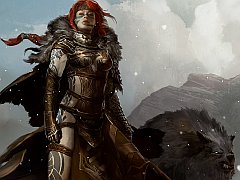Video Gamer is reader-supported. When you buy through links on our site, we may earn an affiliate commission. Prices subject to change. Learn more
New IPs in the MMO sector have risen and crashed with tidal regularity for the last decade thanks to WoW, but Guild Wars was one of the few that didn’t get the rejection slip from the mass market.
Its developers originated from Blizzard’s work mines, but left to form ArenaNet and create an instance-based virtual world largely in response to the MMO tropes that became standardised by WoW.
You might remember the game’s business strategy, for one – an anti-subscription based model that solidified ArenaNet’s role as one of the few high-end MMO developers willing to go the free-to-play route. The game also opted for an instanced world instead of a persistent one. This meant your experience in the game was relatively personalised, and that you weren’t sharing the environment with hundreds of others at a time.
The sequel similarly tries to forge new paths, bur really this is an entirely different beast altogether.
The recent trend for MMORPGs leans toward the story-centric RPG side of the equation, resulting in the development of both this and Star Wars: The Old Republic. Guild Wars has gone back to using a traditional persistent world as its base, but rather than running the risk of seeming derivative – as Old Republic is accused of being in practice – this has helped it become one of the only MMOs in development with a clear sense of identity, post-WoW.
The quest system has been overhauled. Beyond the fact that they’ve done away with the exclamation-marks-atop-of-quest-givers routine, Guild Wars takes a page from Warhammer Online and throws in a dynamic event system – to put it in human English, large-scale, random events that anyone out and about in the world can join. Players can meander between set quests they’ve picked up, and Events like the taking-down of giant Dune-styled worms or the wiping out of pirates raiding a nearby town.
Character creation has undergone a major makeover too. The series has moved on from its initial offering of a single (human) race, and now features a selection of five – including the truly brilliant, enormous bipedal cat things, the Charr. Added on is a fill-in-the-blanks style questionnaire which is designed to customise traits of your character’s personality, determining in turn how NPCs relate to them. These modifiers are largely nebulous (“Your character’s totem animal is a ______,” and so on) but at least they give the impression that, yes, this is a new MMO experience.
Combat itself follows an interesting path. Underwater fights against ocean-based enemies completely change your set of abilities and combine an Elemental Charr’s spells with the water itself to create a mutated version. Fire spells become molten lava and steam, or “boil” the surroundings, for instance. It sounds like a superficial difference in writing, but it means that it opens up an entirely new area for fights in the world of MMOs. Where traditionally water-based combat felt like an odd, floaty second-cousin to above-ground fights, here it’s been legitimised.
Even the notion of dying has been slightly revised. Healing classes have been ditched entirely with revival abilities dished out to characters of all classes, so the frustration of MMO deaths (particularly in pick-up groups where you’re lucky to find anyone remotely competent at hitting the right keys) is lessened.
Similarly, you don’t automatically die when your health plummets. Instead you enter a “Downed” state where you have access to a small handful of skills that allow you to keep fighting enemies while wounded on the ground. If you manage to kill an enemy during this state, you instantly get revived; it’s only if you fail here that even need to depend on others to revive you.
Eight group dungeons will be available at the launch of the game, from level 35 onward. It sounds like a meagre helping but it basically doubles as each has two modes: story and exploration. So despite Guild Wars 2’s narrative leaning, all dungeons are repeatable once you’ve played through story mode. Exploration then offers a new version of the dungeon, with its own specific enemies and boss fights.
But the game proves even superficial differences are as important to developing a personality as any changes to the fundamentals of MMOs. The cities of Guild Wars 2 have an architectural style you don’t see elsewhere. The Norn starting area might essentially be the game’s pseudo-medieval zone of feudal farmyards and coastlines, its buildings and colour schemes making its main areas look like a combination of Holland and a Viking Hilton.
ArenaNet has already openly stated it wants to fill the top dog spot in the genre. Guild Wars 2 will likely be battling it out with World of Warcraft and (potentially) Bioware’s Old Republic at launch, but given the fact that it offers some of the most important advancements to the genre that we’ve seen in years, and that it’s easily one of the most exciting game currently in development, this goal may not be as far-fetched as it initially seems.

/https://oimg.videogamer.com/images/ad27/guild_wars_2_20.jpg)